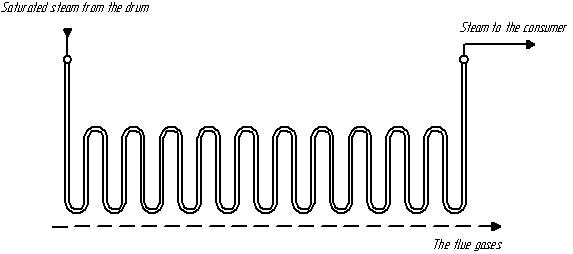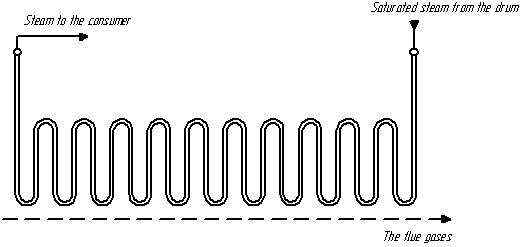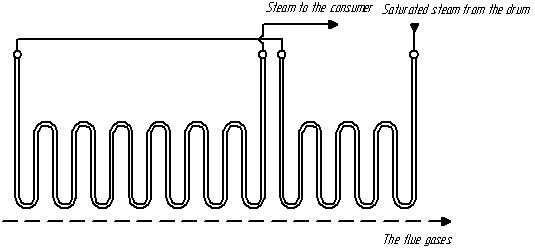Abstract
Content
- Introduction
- 1. Theme urgency
- 2. Goal and tasks of the research
- 3. Investigation of of the advantages and disadvantages of flow of schemes
- 3.1 Co-current circuit
- 3.2 Counter current circuit
- 3.3 Mixed circuit
- Conclusions
- References
Introduction
Superheater are intended for superheating the saturated vapor entering from the evaporating boiler system, and high settings pressures, they are also used for additional secondary superheat steam, partly of spent in the cylinder high-pressure turbine. Superheater is one of the main elements of the boiler heat-up and running in the most difficult conditions. With the rise steam parameters role and importance of superheater increase.
The metal heating surfaces of the superheater has the highest compared to other heat-heating surface temperature, which is due to the high temperatures of steam and high specific heat loads of heating surfaces.
1. Theme urgency
Superheater in power boiler units becomes especially important heating surface. This is due to the fact that increasing the pressure and temperature of the steam relative share of heat consumed for the overheating, increases considerably as with the growth its temperature superheated steam enthalpy increases, and with increasing vapor pressure is reduced.
Masters work is devoted to the actual scientific problem of energy efficiency double-drum steam boiler superheater DKVR type (double-drum vertical water-tube boiler reconstructed), aimed at increasing the life of the superheater when the high parameters of superheated steam. This work lead to lower operational costs for the service boilers of this type, thus to reduce the cost per unit.
2. Goal and tasks of the research
The aim of of research is to improve the energy efficiency of two-drum boiler superheater DKVR type (double-drum vertical water-tube boiler reconstructed), aimed at increasing the life of the superheater when the high parameters of superheated steam.
Main tasks of the research:
- Analysis of the circuit connections superheater downstream of the combustion products.
- Finding the optimal scheme of flow.
- Analysis of the results of research comparing of the theoretical values the parameters of steam and obtained experimentally.
Research object: superheater steam boiler of DKVR.
Research subject: impact of changes in the traffic pattern on the quality of heat transfer fluids and superheated steam for the life of the boiler superheater metal.
3. Investigation of of the advantages and disadvantages of flow of schemes
For reliable operation superheater provide adequate vapor flow rate and temperature uniformity included on parallel coils, and apply the most rational scheme include superheater downstream products combustion. Depending on the direction of flow of steam and combustion products are distinguished once-through steam heaters, Countercurrent and mixed with the flow direction.
3.1 Co-current circuit
In the case of once-through steam superheater in the boiler circuit, the highest temperature of the flue gases corresponds to the lowest temperature of the superheated steam. In principle, this should provide a low metal temperature superheater, but the presence of boiler water droplets coming from the saturated steam from the separation devices drum salts contained in these droplets aredeposit on the forefront of the coils, resulting in a sharp increase in the temperature of the metal. Furthermore, when a movement pattern heat transfer temperature difference is minimal, which requires an increase in the required superheater heating surface[1].

Figure 1 – Co-current circuit of the superheater to the gas stream
3.2 Counter current circuit
When counterflow traffic pattern in the boiler coils, heated products of combustion with the highest temperature, meet and the superheated steam is cooled at this insufficient. As a result, despite the fact that the metal coils superheater in the most severe operating conditions of temperature, temperature difference in the maximum circuit and the necessary heat exchange surfaceminimal, which allows you to steam heaters with this scheme of movement is very compact[1].

Figure 2 – Counter-current circuit of the superheater to the gas stream
3.3 Mixed circuit
Optimal in terms of the reliability of a mixed circuit of the superheater, in the course of which the first pair part superheater runs counter, and completion of superheating occurs in the second part of it at once-through traffic heat transfer fluids. In the part coils located in the areas of highest thermal load superheater (early duct) will moderate steam temperature, and completion of the process of overheating occurs at a lower heat load. The ratio of the countercurrent parts of the superheater and uniflow conditions selected from the same metal temperature at the beginning and end of the coil it uniflow[2].

Figure 3 – Mixed circuit of the superheater to the gas stream
Mixed circuit operates as follows: the saturated steam flows into the second superheater boiler which operates on the countercurrent scheme, and then leaving the second stage into the first superheater running on uniflow scheme.
Conclusions
The use of mixed strategies to incorporate the superheater to the gas flow significantly increased the life of the metal superheater. This scheme is robust, forward-looking, the so-called "golden mean" between "radical" and counter-uniflow circuits.
Masters work is devoted to the actual scientific problem of energy efficiency double-drum steam boiler superheater DKVR type (double-drum vertical water-tube boiler reconstructed), aimed at increasing the life of the superheater when the high parameters of superheated steam. As part of the research done:
- Thermal design of the superheater.
- Strength calculation of boiler components.
- The structural calculation superheater.
- Registration of a patent for utility model.
This master's work is not completed yet. Final completion: December 2013. The full text of the work and materials on the topic can be obtained from the author or his head after this date.
References
- Сидельковский Л.Н., Юренев В.Н. Котельные установки промышленных предприятий. М.:Энергоатомиздат, 1988. - 528 с.
- Зах Р.Г. Котельные установки. М.: Энергия, 1968. - 352 с.
- Частухин В.И. Тепловой расчёт промышленных парогенераторов. – Киев: Высшая школа, 1980. – 184 с.
- Роддатис К.Ф., Бузников Е.Ф. Производственные и отопительные котельные. М.: Энергоатомиздат, 1984. - 248 с.
- Бузников Е.Ф., Крылов А.К., Лесниковский Л.А. Комбинированная выработка пара и горячей воды. М.: Энергоатомиздат, 1981. - 208 с.
- Бузников Е.Ф. Циклонные сепараторы в паровых котлах. М.: Энергия, 1969. 248 с.
- Ривкин С.Л., Александров А.А. Теплофизические свойства воды и водяного пара. М.: Энергия, 1980. – 424 с.
